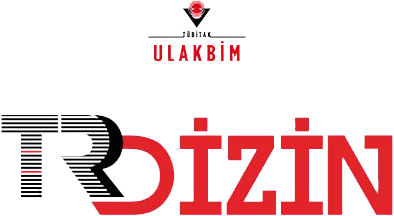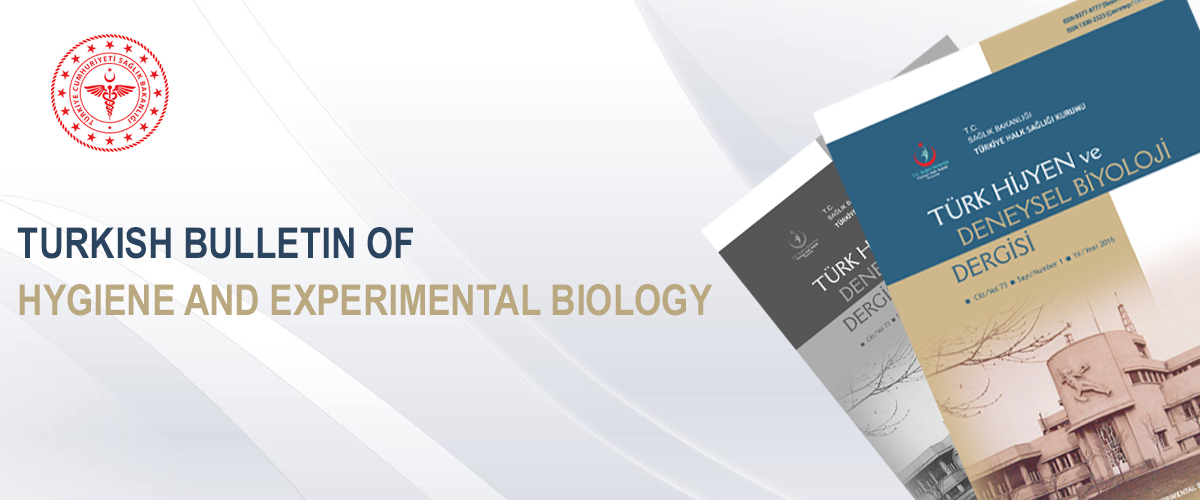
Bu eser Creative Commons Alıntı-GayriTicari-Türetilemez 4.0 Uluslararası Lisansı ile lisanslanmıştır.













Instructions for Authors
I) AIM and SCOPE
The Turkish Bulletin of Hygiene and Experimental Biology (TBHEB) is a publication of the “Republic of Türkiye, Ministry of Health, General Directorate of Public Health ". The Journal is published every three months (March, June, September, December) and one volume consists of four (4) issues.
Goal of the our journal is to publish clinical and experimental research articles which are scientifically qualified and will provide a new contribution to the literature.
The journal publishes biology, microbiology, infectious diseases, pharmacology, toxicology, immunology, parasitology, entomology, chemistry, biochemistry, food safety, environmental, health, public health, epidemiology, pathology, pathophysiology, molecular biology, genetics, biotechnology and health management in the field of original research, case report, reviews, letters to the editor and technical reports.
II) PUBLISHING POLICY
Articles which are not previously published in another journal or not currently under evaluation elsewhere can be accepted for the journal.
Articles approved by the Scientific Committee and Editorial Board are eligible to be released after receiving at least two positive opinions from the Scientific Committee members. The names of the reviewers and authors are kept confidential. Reviewers complete the evaluation processes within three months at the latest.Those committees have the authority to make all corrections and abbreviations but not to change the content of the article.
The authors have the all the scientific and legal responsibilities of the articles.
The authors must fully obey the ethics of research and publication.
III) COPYRIGHT and LICENSING
The authors are responsible for the scientific and ethical liability of the manuscripts. Authors are responsible for the contents of the manuscript and the references. The data, opinions and statements of published articles are authors’ responsibility, and the Editors, Editorial Board and Republic of Türkiye Ministry of Health General Directorate of Public Health deny any responsibility on these subjects. Copyright fee is not paid to the authors.
The authors agree to transfer the copyright to The Turkish Bulletin of Hygiene and Experimental Biology if the article is accepted for publication. However, the authors retain the following rights:
-Registered rights rather than copyrights such as patent etc.
-The right to use it no charge in all educational activities except for publication in journals or books.
-The right to multiply manuscript provided that it is not commercial.
By signing the Copyright Transfer Form, authors agree that the article, if accepted for publication by The Turkish Bulletin of Hygiene and Experimental Biology, will be licensed under a Creative Commons Attribution-NonCommercial-NoDerivatives 4.0 International (CC BY-NC-ND 4.0).
All articles published by The Turkish Bulletin of Hygiene and Experimental Biology are subject to the Creative Commons Attribution-NonCommercial-NoDerivatives 4.0 International License (CC BY-NC-ND 4.0). This License permits use, distribution, and reproduction in any platform, provided that the article is properly cited, the usage is noncommercial, and no modifications or adaptations are made. For more information on the conditions of the license please look at: https://creativecommons.org/licenses/by-nc-nd/4.0/ Permission is required for the protection of copyright holder and author rights in the case of commercial use (sales etc.) of material published under this license. The content can be used as a reference in scientific publications and presentations. Except these conditions, permissions for re-use of manuscripts should be obtained from TBHEB editorial office.
IV) OPEN ACCESS POLICY
The Turkish Bulletin of Hygiene and Experimental Biology has adopted open access policy. Open Access Policy is based on rules of Budapest Open Access Initiative (BOAI). According to BOAI, Open Access states, “Scientific articles that have been evaluated by the referee, via the Internet; be freely accessible, readable, downloadable, copied, distributed, printed, scanned, linked to full texts, indexed, transmitted as data and used for any legal purpose, without financial, legal and technical barriers.
https://www.budapestopenaccessinitiative.org/read
Scientific articles published in the journal are freely available under the Creative Commons 4.0 International License (CC BY-NC-ND 4.0). Our Journal, provides immediate open access to its peer-reviewed scientific literature on the principle of making it freely available to the everyone and supporting a greater global exchange of knowledge. Published articles in The Turkish Bulletin of Hygiene and Experimental Biology are fully comply with Open Access instructions.
The Turkish Bulletin of Hygiene and Experimental Biology instant open access to the articles is provided to make the articles published in journals freely available online all over the world. There is no need to subscribe to access articles. All articles in the system can be accessed and read without being a journal user. There is no fee for article submission, evaluation and publishing.
V) PRICE POLICY
Article submission, evaluation and publication are free.
VI) ETHICAL RULES
The Turkish Bulletin of Hygiene and Experimental Biology expects the authors to comply with the ethics of research and publication. In case the authors do not have a local ethics committee, the principles outlined in the “Declaration of Helsinki” should have been followed. Authors must comply with the internationally accepted guidelines and provisions set out in all applicable legislation when it comes to this type of work.
Ethics Committee Approval must be obtained and documented for all researches requiring ethics committee approval; The name, date and number of the committee should be stated in the method section of the article.
In human research, a statement of the informed consent of those who participated in the study is needed in the section of the “Materials and Methods”. In case of procedures that will apply to volunteers or patients, it should be stated that the study objects have been informed and given their approval before the study started. In case reports, information about the signed informed patient consent form should be included in the article. In case patient information (photograph, etc.) is used which shows patient ID, a written informed consent of the patient must be submitted.
In case animal studies, approval also is needed; it should be stated clearly that the subjects will be prevented as much as possible from pain, suffering and inconvenience. In animal experiments, the study should be conducted in accordance with the ethical regulations specified in the "Guide to the Care and Use of Laboratory Animals" (www.nap.edu/catalog/5140.html) and the authors should declare that the ethics committee approval was obtained and the date and number of the ethics committee in the "Materials and Methods" section. Experimental and clinical drug studies performed in accordance with the Republic of Türkiye Ministry of Health regulations and ethics committee approval must be stated in the article.
The format of the article should be in accordance with ICMJE (International Committee of Medical Journal Editors) and COPE (Committee on Publication Ethics) guidelines.
VII) LANGUAGE of the JOURNAL
The official languages of the our Journal are Turkish and English. The manuscripts written in Turkish have also abstracts in English, and the articles in English have also abstracts in Turkish. The Turkish and English abstracts should be literal translations of each other. When preparing manuscripts, the Turkish Language Institution (www.tdk.gov.tr) is advised for consulting Turkish words and Turkish Medical Terminology (www.tipterimleri.com) for technical terms. Manuscripts in English must absolutely be checked for spelling and grammar. Manuscripts considered insufficient in language will not be considered for evaluation.
VIII) WRITING RULES
Manuscripts submitted for publication in the journal should be prepared according to the writing rules of the Turkish Journal of Hygiene and Experimental Biology. Applications are made online at www.turkhijyen.org via the "Online Manuscript Submit, Track, Evaluate Program".
Articles to be submitted for publication;
- Should have a high scientific level, be original and suitable for reference.
- Information and references should contain up-to-date data for the last 5 (five) years.
- The “Copyright Transfer Form” (Copyright Release Form) after being signed by all authors should be uploaded using the article accepting system of the journal.
The title of article, Turkish title, short title, author name(s), names of institutions and the departments of the author(s), full address of the corresponding author, telephone numbers (landline and mobile), e-mail address should be given. - The title should be short and written in lower case.
- The short title should not exceed 40 characters..
- The study supported by a fund or scientific organisation must be mentioned in a footnote or in the acknowledgements.
- The study presented in a conference/symposium must be mentioned with the type of presentation in footnotes or in the acknowledgements.
- For Turkish studies; Terms used in articles should be in Turkish and Latin as much as possible, according to the latest dictionary of the “Turkish Language Institution”. The language of the articles should be clear, and care should be taken to avoid spelling and writing mistakes.
- Latin names of microorganisms used for the first time in the text have to be written in full. If these names are used later, they should be abbreviated in accordance to international rules. The original Latin names of microorganisms should be written in Italic: for example, Pseudomonas aeruginosa, P.aeruginosa. Names of antibiotics should be abbreviated in accordance with international standards.
- Symbols of the units mentioned in the text should be according to “The Système International (SI).
- Articles should be written in one of the “past perfect, present perfect and past” tenses and in the passive mode.
- Only one side of A4 paper should be used and should have a 2.5 cm margin on each side. 12 pt, Times New Roman font and double line space should be used.
- Research Articles;
Research papers should consist of Turkish abstract, English abstract, Introduction, Materials and Methods, Results, Discussion, Acknowledgements (if any), and References sections. These sections should be written in bold capital letters and aligned left. English articles should have a Turkish abstract and title in Turkish. (If the all of the authors from abroad the manuscript and abstract can be write English language). Abstracts should be prepared in an extremely comprehensive way; it should not contain grammatical, spelling and writing errors.
a) Turkish Abstract: Should consist of the subheadings of Objective, Methods, Results and Conclusion (Structured Abstract). It should be between 250 and 400 words.
b) English Abstract: The abstract should be structured like the Turkish abstract (Objective, Methods, Results, and Conclusion). It should be between 250 and 400 words.
c) Key words:s The number of keywords should be between 3-8 and the terminology of the Medical Subjects Headings (Index Medicus Medical Subject Headings-MeSH) should be used.
d) Introduction: The aim of the study, and references given to similar studies should be presented briefly and should not exceed more than two pages.
e) Materials and Methods: The date of the study, institution that performed the study, and materials and methods should be clearly presented. Statistical methods should be clearly stated.
f) Results: The results should be stated clearly and only include the current research.
g) Conclusions: In this section, the study findings should be compared with the findings of other researchers. Authors should mention their comments in this section.
h) Acknowledgements: Should be placed at the end of the main text and before the references. In this section, the institutions/departments which supported the research should be stated.
i) References: Authors are responsible for supply complete and correct references. References should be numbered according to the order used in the text. Numbers should be given in brackets and placed at the end of the sentence. Examples are given below on the use of references. Detailed information can be found in “Uniform Requirements for Manuscripts Submitted to Biomedical Journals” (J Am Med Assoc 1997 277: 927-934) and at http://www.nejm.org/general/text/requirements/1.htm
- Periodicals: Author(s) Last Name initial(s) name of author(s) (if there are six or fewer authors, all authors should be written; if the number of authors are seven or more, only the first six of the authors should be written and the rest as “et al”). The title of the article, the abbreviated name of the journal according to the Index Medicus, Year; Volume (Issue): The first and last page numbers.
- Example of standard journal article: Demirci M, Unlü M, Sahin U. A case of hydatid cyst diagnosed by kinyoun staining of lung bronco-alveolar fluid. Turkiye Parazitol Derg, 2001; 25 (3): 234-5.
- Example of an article with authors unknown: Anonymous. Coffee drinking and cancer of the pancreas (Editorial). Br Med J, 1981; 283:628.
- Example of journal supplement: Frumin AM, Nussbaum J, Esposito M. Functional asplenia: Demonstration of splenic activity by bone marrow scan (Abstract). Blood, 1979; 54 (Suppl 1): 26a.
- Books: Surname of the author(s) initial name(s) of author(s). The name of the book. The edition number. Place of publication: Publisher, Publication year. - Example: Eisen HN. Immunology: an Introduction to the Principles of Molecular and Cellular Immune Response. 5th ed. New York: Harper and Row, 1974.
- Book chapters: The author(s) surname of the chapter initial(s) letter of the name. Section title. In: Surname of editor(s) initial (s) letter of first name(s) ed / eds. The name of the book. Edition number. Place of publication: Publisher, year of publication: The first and last page numbers of the chapter.
- Example: Weinstein L. Swarts MN. Pathogenic properties of invading microorganisms. In: Sodeman WA Jr, Sodeman WA, eds. Pathologic Physiology: Mechanism of Disease. Phidelphia. WB Saunders, 1974:457-72.
- Web address: If a “web” address is used as the reference address, the web address date should be given in brackets with the address. The DOI (Digital Object Identifier) number must be provided, when a web access article used in the text as a reference.
- Congress papers: EEntrala E, Mascaro C. New structural findings in Cryptosporidium parvum oocysts. Eighth International Congress of Parasitology (ICOPA VIII). October, 10-14, Izmir-Türkiye. 1994.
- Thesis: Bilhan Ö. Experimental investigation of the hydraulic characteristics of labyrinth weir. Master Thesis, Science Institute of Firat University, 2005.
- GenBank / DNA sequence analysis: DNA sequences of genes and heredity numbers should be given as references in the article. For more information, check “National Library of Medicine” and “National Center for Biotechnical Information (NCBI)”.
- Figure and Tables: Each table or figure should be printed on a separate sheet, the top and bottom lines and if necessary column lines must be included. Tables should be numbered like “Table 1.” and the table title should be written above the top line of the table.
Explanatory information should be given in footnotes, not in the title and appropriate icons (*,+,++, etc.) should be used. Photos should be in “jpeg” format. In case the quality of the photos is not good for publication, the originals can be requested.
- Research articles should have up to 40 references.
- In reviews, it is preferred to have not more than two authors. Author(s) must have done research and published articles previously on this subject; they should discuss their experience and use as reference in the review. Reviews should have Turkish and English titles, abstracts (it should contain minimum 250, maximum 400 words) and key words. Reference numbers for the review should be maximum 60.
- Case reports, should have a maximum of seven pages of text. Case report should have a Turkish and English title, abstract, keywords and also introduction, case description and discussion sections should be given. Number of references should be maximum 20.
- Letters to Editor:Written to make criticisms, additions to previously published articles or scientific updates are published after review and assessment of the Editorial Board. Letters should not exceed one page of text and must be supported with up to 10 references.
- Technical Report, thould contain information that may contribute significantly to the relevant field. Technical reports should include Turkish and English titles, Turkish and English abstracts in a single paragraph, keywords in Turkish and English. The number of references should be maximum 10.
- The articles which do not comply with the journal rules are not accepted.
- Authors should keep a copy of the article that they submit.




